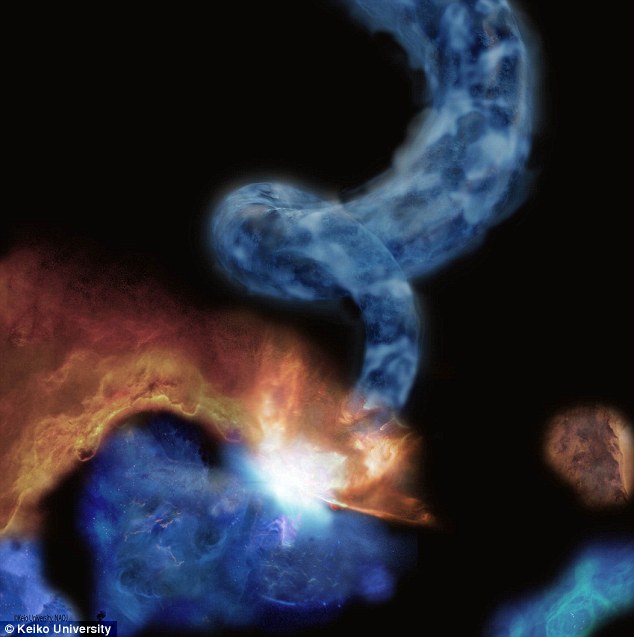Scientists have discovered some of the building blocks of life – known as nitriles – in the heart of our Milky Way.
They were spotted in a molecular cloud of gas and dust by a team of international researchers using two telescopes in Spain.
Nitriles are important building blocks for RNA – a DNA-like nucleic acid found in all living cells.
Experts said their discovery indicates that nitriles are among the most abundant chemical families in the universe, supporting an “RNA world” theory about the origin of life.
This indicates that life on Earth originally depended only on RNA, and that DNA and proteolytic enzymes evolved later.
RNA can perform both of their functions: storing and transcribing information such as DNA, and catalysing reactions such as enzymes.
According to the “RNA World” theory, nitriles and other building blocks of life do not necessarily have to have originated on Earth itself.
The Discovery: Scientists have discovered some of the building blocks of life – known as nitriles – in the heart of our Milky Way. They were spotted in a molecular cloud of gas and dust (similar to the one pictured) by a team of international researchers.

Experts said their discovery indicates that nitriles are among the most abundant chemical families in the universe, supporting an “RNA world” theory about the origin of life. This indicates that the nitrile may have originated in space and ‘launched’ to young Earth within meteorites and comets (stored image)
It may also have originated in space and ‘moved’ to young Earth within meteorites and comets during the ‘Late Heavy Bombardment’ period, between 4.1 and 3.8 billion years ago.
As a support, nitriles and other elementary molecules of nucleotides, lipids, and amino acids have been found within modern comets and meteorites.
The question is, where can these particles come from in space?
The main filter is molecular clouds, which are dense and cold regions of the interstellar medium, which are suitable for the formation of complex molecules.
For example, the G + 0.693-0.027 molecular cloud has a temperature of about 100 K, a width of about three light-years, and a mass about a thousand times the mass of our Sun.
There is no evidence that stars are currently forming within G+ 0.693-0.027, although scientists suspect that it may evolve into a stellar nursery in the future.
The team of experts discovered a range of nitriles including cyanoallene, propargyl cyanide, cyanopropyne and possibly cyanoformaldehyde and glycolonitrile, which had not been previously found in the cloud, defined as G + 0.693-0.027.
“Here we show that the chemistry that occurs in the interstellar medium is able to efficiently synthesize multiple nitrates, which are essential molecular precursors for the ‘DNA world’ scenario, said lead study author Dr. Victor M. Rivilla, a researcher at the Astrobiology Center of the Spanish National Research Council. Ribi”.
He added: ‘The chemical content of G + 0.693-0.027 is similar to that of other star-forming regions in our galaxy, as well as the content of solar system objects such as comets.
This means that his study could give us important insights into the chemical components that were available in the nebula and that gave rise to our planetary system.
The researchers used the 100-foot (30 m) Granada IRAM Telescope, and the 130-foot (40 m) YEPS Telescope in Guadalajara.
The team of experts discovered a range of nitriles including cyanoallene, propargyl cyanide and cyanopropyne, which have not yet been found at G+ 0.693-0.027, although they were reported in 2019 in the TMC-1 dark cloud in the constellations. and Auriga, a molecular cloud with conditions very different from G+ 0.693-0.027.
The scientists also found potential evidence for cyanoformaldehyde and glycolonitrile.
Cyanoformaldehyde was first detected in the molecular clouds of TMC-1 and Sgr B2 in the constellation of Sagittarius, and glycolonitrile in the sun-like protostar IRAS16293-2422 B in the constellation Ophiuchus.

In order to form DNA and RNA, two types of chemical building blocks are needed – or nucleobases
Fellow study author Dr. Miguel A Requena Torres, a lecturer at Towson University in Maryland, said: “Thanks to our observations over the past few years, including current results, we now know that nitriles are among the most abundant chemical families in the world. Universe.
We found them in molecular clouds in the center of our galaxy, protostars of different masses, meteorites and comets, as well as in the atmosphere of Titan, the largest of Saturn’s moons.
“So far we have discovered many simple precursors of nucleotides, which are the building blocks of RNA,” said author Dr Izaskun Jiménez-Serra, who is also a researcher at the Center for Astrobiology of the Spanish National Research Council.
But there are still key molecules missing that are difficult to detect.
For example, we know that the origin of life on Earth probably also required other molecules such as lipids, which are responsible for the formation of the first cells.
We should therefore also focus on understanding how lipids are formed from simpler precursors available in the interstellar medium.
The study was published in the journal the border.

“Extreme travel lover. Bacon fanatic. Troublemaker. Introvert. Passionate music fanatic.”







More Stories
A fossilized creature may explain a puzzling drawing on a rock wall.
MrBeast Sued Over ‘Unsafe Environment’ on Upcoming Amazon Reality Show | US TV
Watch comets Lemmon and SWAN approach Earth today